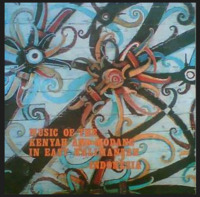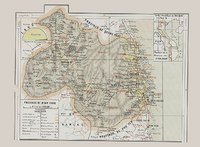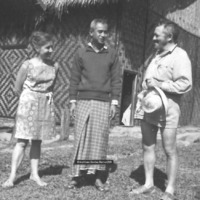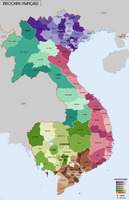Items
-
 Gamelan Selunding: Ritual love court dance Redjang Music recordings made in Bali (Indonesia) by Louis Berthe and Bernard Yzerdraat, in 1961, 1962 and 1963.
Gamelan Selunding: Ritual love court dance Redjang Music recordings made in Bali (Indonesia) by Louis Berthe and Bernard Yzerdraat, in 1961, 1962 and 1963. -
Tutorial video of the Pratinada interfaceInterface functionalities
-
 Son de l'arc à vide Field recordings made on Atauro Island (Timor-Leste), 2019-2023, by Dana Rappoport.
Son de l'arc à vide Field recordings made on Atauro Island (Timor-Leste), 2019-2023, by Dana Rappoport. -
Ənjuk haloʔ (mixed influences)Music of the Kenyah and Modang recorded in 1977 by I Made Bandem, Nicole Revel-Macdonald and Jose Maceda, published with financial assistance of Unesco and Directorate of Culture of Indonesia. SIDE II - Modang. D - Cure of the sick.
-
Ənjuk modang (solo singer)Music of the Kenyah and Modang recorded in 1977 by I Made Bandem, Nicole Revel-Macdonald and Jose Maceda, published with financial assistance of Unesco and Directorate of Culture of Indonesia. SIDE II - Modang. D - Cure of the sick.
-
Jɔng nyəlong (group of women)Music of the Kenyah and Modang recorded in 1977 by I Made Bandem, Nicole Revel-Macdonald and Jose Maceda, published with financial assistance of Unesco and Directorate of Culture of Indonesia. SIDE II - Modang. C - Songs
-
Nɔk Naʔ (solo and chorus)Music of the Kenyah and Modang recorded in 1977 by I Made Bandem, Nicole Revel-Macdonald and Jose Maceda, published with financial assistance of Unesco and Directorate of Culture of Indonesia. SIDE II - Modang. C - Songs
-
Tongluk təgguk (bamboo percussion)Music of the Kenyah and Modang recorded in 1977 by I Made Bandem, Nicole Revel-Macdonald and Jose Maceda, published with financial assistance of Unesco and Directorate of Culture of Indonesia. SIDE II - Modang. B - Other instruments
-
Tong buwɛh (jew's harp)Music of the Kenyah and Modang recorded in 1977 by I Made Bandem, Nicole Revel-Macdonald and Jose Maceda, published with financial assistance of Unesco and Directorate of Culture of Indonesia. SIDE II - Modang. B - Other instruments
-
Lukunwut (ring flute)Music of the Kenyah and Modang recorded in 1977 by I Made Bandem, Nicole Revel-Macdonald and Jose Maceda, published with financial assistance of Unesco and Directorate of Culture of Indonesia. SIDE II - Modang. B - Other instruments
-
Əgung (gong) and təwung (drum)Music of the Kenyah and Modang recorded in 1977 by I Made Bandem, Nicole Revel-Macdonald and Jose Maceda, published with financial assistance of Unesco and Directorate of Culture of Indonesia. SIDE II - Modang. A - Ritual song, gongs and drums
-
Ləppoʔ maut (for jatung utang, xylophone and sampɛʔ, lute)Music of the Kenyah and Modang recorded in 1977 by I Made Bandem, Nicole Revel-Macdonald and Jose Maceda, published with financial assistance of Unesco and Directorate of Culture of Indonesia. SIDE II - Modang. A - Ritual song, gongs and drums
-
Jatung utang (wooden xylophone)Music of the Kenyah and Modang recorded in 1977 by I Made Bandem, Nicole Revel-Macdonald and Jose Maceda, published with financial assistance of Unesco and Directorate of Culture of Indonesia. SIDE I - Kenyah. C - Songs and other musical instruments.
-
Tidaw (women's song)Music of the Kenyah and Modang recorded in 1977 by I Made Bandem, Nicole Revel-Macdonald and Jose Maceda, published with financial assistance of Unesco and Directorate of Culture of Indonesia. SIDE I - Kenyah. C - Songs and other musical instruments.
-
Liyung bayu (for uding, jew's harp)Music of the Kenyah and Modang recorded in 1977 by I Made Bandem, Nicole Revel-Macdonald and Jose Maceda, published with financial assistance of Unesco and Directorate of Culture of Indonesia. SIDE I - Kenyah. C - Songs and other musical instruments.
-
Kədingət (two flutes)Music of the Kenyah and Modang recorded in 1977 by I Made Bandem, Nicole Revel-Macdonald and Jose Maceda, published with financial assistance of Unesco and Directorate of Culture of Indonesia. SIDE I - Kenyah. C - Songs and other musical instruments.
-
Təluy (prompter-leader-chorus singing)Music of the Kenyah and Modang recorded in 1977 by I Made Bandem, Nicole Revel-Macdonald and Jose Maceda, published with financial assistance of Unesco and Directorate of Culture of Indonesia. SIDE I - Kenyah. C - Songs and other musical instruments.
-
Lutong (bamboo zithers)Music of the Kenyah and Modang recorded in 1977 by I Made Bandem, Nicole Revel-Macdonald and Jose Maceda, published with financial assistance of Unesco and Directorate of Culture of Indonesia. SIDE I - Kenyah. C - Songs and other musical instruments.
-
Bəttik nilun (tatooing song)Music of the Kenyah and Modang recorded in 1977 by I Made Bandem, Nicole Revel-Macdonald and Jose Maceda, published with financial assistance of Unesco and Directorate of Culture of Indonesia. SIDE I - Kenyah. C - Songs and other musical instruments.
-
Kanjɛt Təngən Ləttɔh (Dance With Sampɛʔ, Lute)Music of the Kenyah and Modang recorded in 1977 by I Made Bandem, Nicole Revel-Macdonald and Jose Maceda, published with financial assistance of Unesco and Directorate of Culture of Indonesia. SIDE I - Kenyah. B - Lute and mouth organ
-
Jagang tigang (music for sampɛʔ, lute)Music of the Kenyah and Modang recorded in 1977 by I Made Bandem, Nicole Revel-Macdonald and Jose Maceda, published with financial assistance of Unesco and Directorate of Culture of Indonesia. SIDE I - Kenyah. B - Lute and mouth organ
-
Udo kita, udo kibah, udo taing and udo maok (masks in a dance with kədirek, mouth organ)Music of the Kenyah and Modang recorded in 1977 by I Made Bandem, Nicole Revel-Macdonald and Jose Maceda, published with financial assistance of Unesco and Directorate of Culture of Indonesia. SIDE I - Kenyah. B - Lute and mouth organ
-
Parap (solo ritual dance with leader-chorus singing)Music of the Kenyah and Modang recorded in 1977 by I Made Bandem, Nicole Revel-Macdonald and Jose Maceda, published with financial assistance of Unesco and Directorate of Culture of Indonesia. SIDE I - Kenyah. A - Music for entertainment, feasts, celebrations
-
Dayung lung balau (welcome ceremony with leader-chorus singing)Music of the Kenyah and Modang recorded in 1977 by I Made Bandem, Nicole Revel-Macdonald and Jose Maceda, published with financial assistance of Unesco and Directorate of Culture of Indonesia. SIDE I - Kenyah. A - Music for entertainment, feasts, celebrations
-
Ləsɔng undat (gigantic mortar to pound rice)Music of the Kenyah and Modang recorded in 1977 by I Made Bandem, Nicole Revel-Macdonald and Jose Maceda, published with financial assistance of Unesco and Directorate of Culture of Indonesia. SIDE I - Kenyah. A - Music for entertainment, feasts, celebrations
-
Təwung (long conical drums)Music of the Kenyah and Modang recorded in 1977 by I Made Bandem, Nicole Revel-Macdonald and Jose Maceda, published with financial assistance of Unesco and Directorate of Culture of Indonesia. SIDE I - Kenyah. A - Music for entertainment, feasts, celebrations
-
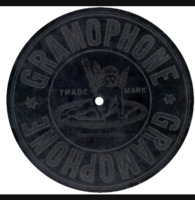 Gramophone Company The Gramophone Company was founded in April 1898 by William Barry Owen and Edmund Trevor Lloyd Wynne Williams, commissioned by Emil Berliner, in London. It was one of the earliest record labels (Wikipedia).
Gramophone Company The Gramophone Company was founded in April 1898 by William Barry Owen and Edmund Trevor Lloyd Wynne Williams, commissioned by Emil Berliner, in London. It was one of the earliest record labels (Wikipedia). -
 Dangan sentara bounga melati ; Terang boulang ; Nina bobo (Three popular songs) Pathé record, Musée de la Parole, Hubert Pernot
Dangan sentara bounga melati ; Terang boulang ; Nina bobo (Three popular songs) Pathé record, Musée de la Parole, Hubert Pernot -
 Conte populaire en langue malaise: Bawang pounti sama bawang mera Pathé record, Musée de la Parole, Hubert Pernot
Conte populaire en langue malaise: Bawang pounti sama bawang mera Pathé record, Musée de la Parole, Hubert Pernot -
The Phonogrammarchiv, Austrian Academy of SciencesThe Phonogrammarchiv was founded in 1899 in Vienna, Austria. 3144 phonograms have been collected (200 wax cykinder) from all regions (Papua, Indonesia, Myanmar, Thailand, Malaysia, ...)
-
Colonial Archives, Leiden University LibrariesThis site provides access to the digitised and digital born collections of Leiden University Libraries (NL)
-
Unesco Recommendation concerning heritageRecommendation oncerning the preservation of, and access to, documentary heritage including in digital form (2015)
-
Beka RecordsBeka Records was a record label based in Germany, active from about 1903 to 1925. Before World War I, Beka also made gramophone records for the United Kingdom market under the Beka-Grand Records label. The company became a subsidiary of the Carl Lindström Company which was sold to the Columbia Graphophone Company in 1926. Slawoma - Der neueste Tanz (Slavoma) by Engelbert Zaschka. Saxophon-Orchester Dobbri of Berlin, 1925 Artists on the label included Bert Alvey, Jessie Broughton, Albertina Cassani, Lucia Cavalli, Cook & Carpenter, Gerhard Ebeler, Kappelle Willy Krug, Kapelle Merton, Miss Riboet, Phillip Ritte, the Beka London Orchestra, the Dobbri Saxophone Orchestra, the Martina Salon Orchestra, the Meister Orchestra, and the Royal Cowes Minstrels. A history of Beka Records, together with a listing of known records issued by the label, is published by the City of London Phonograph and Gramophone Society (CLPGS) as part of their Reference Series of books. Source:
-
His Master's VoiceHis Master's Voice (HMV) was the name of a major British record label created in 1901 by The Gramophone Co. Ltd. The phrase was coined in the late 1890s from the title of a painting by English artist Francis Barraud, which depicted a dog named Nipper listening to a wind-up disc gramophone and tilting his head. In the original, unmodified 1898 painting, the dog was listening to a cylinder phonograph. The painting was also famously used as the trademark and logo of the Victor Talking Machine Company, later known as RCA Victor. The painting was originally offered to James Hough, manager of Edison-Bell in London, but he declined, saying "dogs don't listen to phonographs". Barraud subsequently visited The Gramophone Co. of Maiden Lane in London where the manager William Barry Owen offered to purchase the painting if it were revised to depict their latest Improved Gramophone model. Barraud obliged, and Owen bought the painting from Barraud for £100. In the 1970s, an award was created with a copy of the statue of the dog and gramophone, His Master's Voice, cloaked in bronze, and was presented by (EMI Records) to artists, music producers and composers in recognition of selling more than 1,000,000 records. Source:
-
 Kecak chorus Appearing in its present form at the beginning of the 1930s, this genre drew from older models, such as the trance-dances as practised in temples. A chorus of men, some forty performers, seated in concentric circles facing towards the centre, where a scene from the Ramayana is played, with the texts declaimed by actors. The chorus itself performs a polyphony of diverse cries and onomatopoeias, wherein the syllables [ke] and [cak] (pronounced "cha") are stylised monkey calls. The result is a varied rhythmic counterpoint, mainly using techniques of hocket, ostinato and off-beat. Synchronisation betwecn the different parts is rigorously directed by one of the members in the chorus, a sort-of conductor whose signals can be clearly heard. There is no place for improvisation, and all the parts, whose number vary during a performance, have been learned by heart.
Kecak chorus Appearing in its present form at the beginning of the 1930s, this genre drew from older models, such as the trance-dances as practised in temples. A chorus of men, some forty performers, seated in concentric circles facing towards the centre, where a scene from the Ramayana is played, with the texts declaimed by actors. The chorus itself performs a polyphony of diverse cries and onomatopoeias, wherein the syllables [ke] and [cak] (pronounced "cha") are stylised monkey calls. The result is a varied rhythmic counterpoint, mainly using techniques of hocket, ostinato and off-beat. Synchronisation betwecn the different parts is rigorously directed by one of the members in the chorus, a sort-of conductor whose signals can be clearly heard. There is no place for improvisation, and all the parts, whose number vary during a performance, have been learned by heart. -
 Heyalo song A heyalo song, by Ulahi and Eyoobo. In Kaluli conception, the two voices do not "follow" one another, but "lift up over" (dulugu molab), in a sort of echoing. The heyala songs may be performed either during ceremonies or for personal diversion. Composed in the traditional style, for some ceremonies held about 1970, this heyalo is sung here by two women during a pause from work in the gardens. The text compares some children to doves, flying off, to a distant school, stopping at each village to tell their parents, brothers and sisters : "l won't be coming back".
Heyalo song A heyalo song, by Ulahi and Eyoobo. In Kaluli conception, the two voices do not "follow" one another, but "lift up over" (dulugu molab), in a sort of echoing. The heyala songs may be performed either during ceremonies or for personal diversion. Composed in the traditional style, for some ceremonies held about 1970, this heyalo is sung here by two women during a pause from work in the gardens. The text compares some children to doves, flying off, to a distant school, stopping at each village to tell their parents, brothers and sisters : "l won't be coming back". -
 Harmonic melody (insect) Melody on harmonics, by Kabyo (son of) Nuwas, using the buzzing of a beetle (fut mwag). The beetle is attached by its legs to a stem, then held in front of the mouth while it attempts to fly away. The insect provides an "instrumental" drone. By modifying the volume of the buccal cavity serving as resonator, the boy selects harmonics to make a melody (an analagous technique to that of the jew'
Harmonic melody (insect) Melody on harmonics, by Kabyo (son of) Nuwas, using the buzzing of a beetle (fut mwag). The beetle is attached by its legs to a stem, then held in front of the mouth while it attempts to fly away. The insect provides an "instrumental" drone. By modifying the volume of the buccal cavity serving as resonator, the boy selects harmonics to make a melody (an analagous technique to that of the jew'
